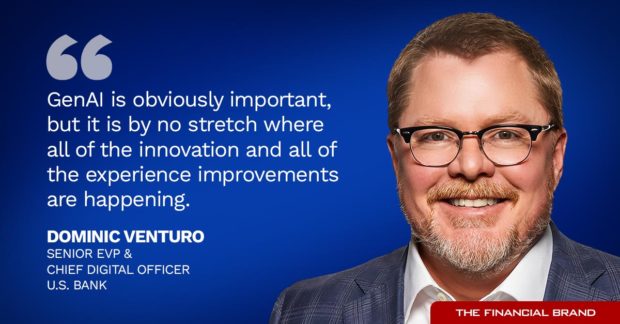Dominic Venturo’s long banking career in banking innovation has taught him some key lessons about making change happen. One is that some of the best ideas aren’t possible yet.
Years ago, Dominic Venturo learned a lesson about banking innovation that has stuck.
Venturo, now senior executive vice president and chief digital officer at U.S. Bank, was in a roomful of bank technologists and other experts. The conversation concerned the implementation of Check 21, which introduced electronic checks and ended the days of flying huge bags of paper checks around the country for processing.
An integral part of Check 21— revolutionary in its day — was taking pictures of checks so their journey would be virtual, not physical. All kinds of questions, opinions and concerns got aired in the room that day.
And then one of those present — Venturo says it was the bank’s chief technologist of the time — said, “We’ve got to think about this entirely differently. What if somebody could just take a picture of a check and deposit it from their home?”
Mind you, what makes that moment stand out for Venturo is that the bank technologist made the comment before smart phones even existed. The iPhone came out in 2007. Check 21, officially the Check Clearing for the 21st Century Act, went into effect in 2004.
“We were all sort of like ‘poof!’ — but when you remove barriers to your thinking, you can come up with some really interesting ideas,” says Venturo. He says the banker’s key point was that you have to think about what hasn’t happened yet, otherwise you’ll spend a mountain of money implementing new systems that won’t connect to technology to come. Ultimately, brainstorming must remove the constraints of today, even theoretically, to see through to possible tomorrows.
“You don’t know where the road’s going to go, but you do know that there are maybe six possible branches to the road that are the most probable. You have to think about all of them,” says Venturo in an interview with The Financial Brand.
Thinking this way demands considering what must come downstream of the innovation, Venturo continues. He was involved in the early development stages of the Real-Time Payments Network of The Clearing House. The group he was working with realized that the capabilities that could be built into the payments stream would necessitate changes for all — more work.
“But when you get to the other side of that, you can unlock tremendous efficiencies,” he says.
Product development roadmaps require architectures that include flexibility that the nimble can exploit.
“That’s important,” says Venturo, “because you don’t want to build a road to nowhere.” Not when financial innovation has a long road ahead. Where will that road lead?
Banking Innovation’s Future Isn’t All About GenAI
Venturo remembers the days when innovation was very new for banking, and leaders and technologists alike saw a fledgling fintech industry preparing to eat the industry’s lunch. The banking industry, by contrast, mostly had slow tools and a creaking tech infrastructure.
Much of that has changed, but innovation keeps moving. Now, there’s so much talk about artificial intelligence, especially GenAI, that it might seem bank innovation will hang entirely on AI going forward.
Not so, says Venturo.
“GenAI is obviously important, but it is by no stretch where all of the innovation and all of the experience improvements are happening.”
GenAI holds center stage right now because it’s new, says Venturo. Also, the excitement level stays high because large language models and related tech made it possible to utilize forms of AI that have been available to banks for years, but that could only be accessed with the talents of data engineers and other specialists beforehand.
“The sea change was the human interface, and the simplicity of use and not needing to know all those specialized things because you could use a finely tuned large language model and find use cases for it,” says Venturo. “So, it has the capability to scale pretty rapidly.”
But GenAI won’t be the whole game. Venturo says banking will tap many other enabling technologies. Application programming interfaces (APIs), migration of more and more into the cloud, and modern processing architecture will all have a part.
“There’s a ton of capabilities that don’t require AI within those spaces to be able to do it,” says Venturo.
Not to take away from AI’s importance. Venturo recently decided to spin AI out of his bank’s Innovation Group. AI had been one of multiple leading-edge technologies based there, but Venturo saw that things had changed.
“We saw that AI is going to be a practice now, so we graduated it from innovation and we’re putting it into a business,” says Venturo. “The AI center of excellence business now reports up to me.”
The CoE is supported by the establishment of an enterprise data product office. The AI center is one of several areas in the bank that the data office will serve. It will also dovetail with digital experience development and digital marketing.
Source: The Financial Brand




Recent Comments